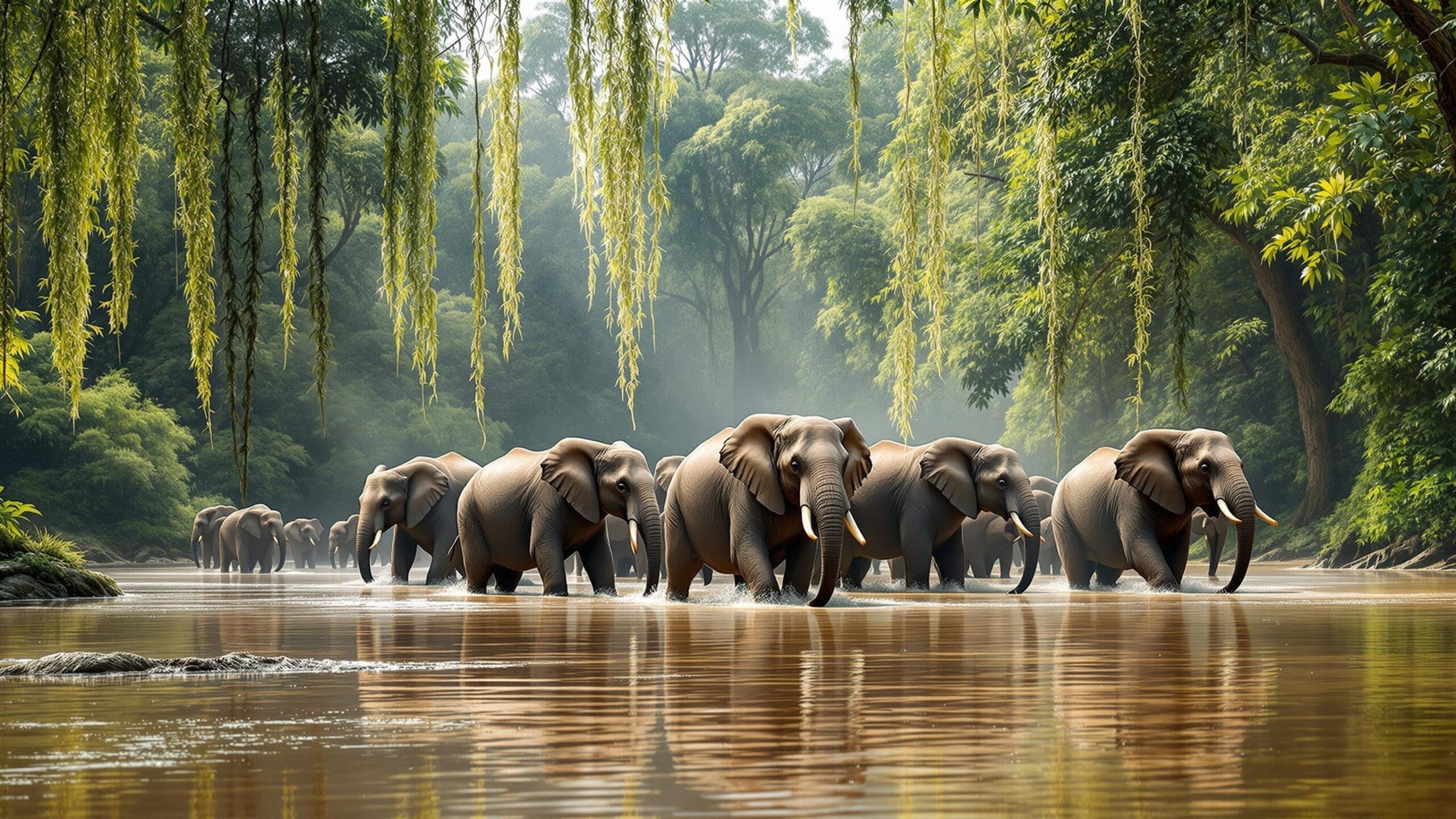Loxodonta cyclotis—Africa’s Elusive Elephant
Deep in the heart of Africa’s most mysterious jungles, a silent giant moves through shadows and sunlight—unseen by most, yet critical to the forest’s very existence. This is the African Forest Elephant, scientifically named Loxodonta cyclotis. For decades, these animals were mistaken for their larger savannah cousins, but modern science now recognizes them as a distinct species, with their own fascinating story. Smaller, stealthier, and perfectly adapted to life under the thick forest canopy, the African Forest Elephant is one of the world’s most intriguing and essential creatures. Join us as we journey into the lush, tangled world of Africa’s rainforests to discover the habits, traits, and wonders of this unique pachyderm.
Physical Characteristics: Nature’s Blueprint for Jungle Survival
The African Forest Elephant stands apart from its more famous relative, the African Bush Elephant, in several remarkable ways. At first glance, it might be easy to confuse the two, but a closer look reveals key differences. Forest Elephants are notably smaller, with adults standing between 7 and 10 feet at the shoulder and weighing up to 5 tons—still massive, yet more compact and agile than the bush variety. Their ears are smaller and more rounded, helping them navigate dense thickets without snagging on vines or branches. The tusks of Loxodonta cyclotis are particularly striking: thinner, straighter, and tinged with a pinkish hue, perfectly suited for slipping between tree trunks and prying fruit from the forest floor. These tusks are denser than those of other elephants, highly prized (and unfortunately targeted) for ivory. Forest Elephants sport a darker, smoother skin, providing natural camouflage in the filtered light of the rainforest. Their trunks are exceptionally dexterous, ending in two “fingers” for delicately plucking leaves and fruit. Every aspect of their body tells the story of a species fine-tuned for life beneath the canopy.
Habitat and Distribution: The Rainforest Realm
The African Forest Elephant is a creature of the world’s second-largest rainforest—the Congo Basin—and several other forested regions of Central and West Africa. Their range covers countries like Gabon, Republic of the Congo, Cameroon, Central African Republic, Democratic Republic of the Congo, Côte d’Ivoire, Ghana, Liberia, and parts of Nigeria. These forests are some of the planet’s most diverse and vital ecosystems, storing vast amounts of carbon and sheltering thousands of unique species. Within this green kingdom, Forest Elephants are masters of stealth. They follow ancient trails between clearings, rivers, and mineral-rich mud wallows called “bais.” These open spaces are the best places to spot them in the wild, as they emerge from the undergrowth to socialize, drink, and dig for vital nutrients. Life in the rainforest is challenging: visibility is limited, paths are often waterlogged, and food resources are scattered and seasonal. But the African Forest Elephant is supremely adapted to this environment, making it one of the few large animals capable of thriving in such dense cover.
Social Life: Quiet Families in the Green Shadows
African Forest Elephants are highly social, yet their family structure is somewhat different from the larger bush elephants of the savannah. Groups tend to be smaller, typically made up of a few related females and their young. These matriarchal groups offer protection, guidance, and a crucial sense of continuity. The forest, with its limited space and resources, supports smaller herds, but the bonds within are just as strong. Unlike bush elephants, which may form huge, open herds, Forest Elephants live quieter, more secretive lives. Adult males, once they reach adolescence, usually roam alone or in small bachelor groups, crossing paths with family herds only during mating seasons or at popular mineral licks. Communication among Forest Elephants is subtle and sophisticated. They use a blend of soft rumbles, gentle trunk touches, and seismic signals—vibrations that can be felt through the ground. These signals help them keep in touch across the labyrinthine forest, where sight lines are limited and danger can lurk behind every trunk.

Feeding Habits: The Great Gardeners of the Rainforest
The African Forest Elephant is, above all, a connoisseur of the rainforest’s bounty. Their diet is varied and adventurous, including leaves, bark, fruit, seeds, and roots. In fact, Forest Elephants are among the most important fruit-eating animals in Africa. Some of the rainforest’s largest and most nutritious fruits, such as wild mangoes and marulas, are too tough for other animals but are a favorite treat for these elephants. As they move through the forest, elephants spread seeds far and wide through their dung, acting as mobile gardeners. Many plant species depend almost exclusively on elephants for their propagation. Without them, some trees and plants might struggle to survive, altering the entire ecosystem.
During the dry season or when food is scarce, Forest Elephants use their tusks to strip bark and dig for hidden roots. Their foraging can open up dense vegetation, allowing sunlight to reach the forest floor and encouraging new growth. In this way, they shape the forest itself, maintaining the delicate balance that allows so much life to flourish.
Adaptations: Surviving the Forest’s Challenges
Every feature of the African Forest Elephant is a testament to adaptation. Their smaller size and rounded backs help them maneuver through tight spaces. Their highly sensitive trunks allow them to “see” the world through touch and smell, compensating for the poor visibility of their environment. Their large, padded feet help them walk quietly over soft, often muddy ground. In addition to physical adaptations, Forest Elephants have evolved behaviors to reduce their risk of predation. Calves are kept in the center of the group, shielded by adults, and herds move with caution, pausing frequently to listen and sniff for signs of danger. The forest is home to leopards, crocodiles, and—occasionally—lions, but the biggest threat by far is humans.
Role in the Ecosystem: The Keystone of the Congo
It’s no exaggeration to say that the African Forest Elephant is the engine that drives the rainforest. Through their foraging, seed dispersal, and habit of opening up pathways, elephants keep the forest healthy and diverse. Some scientists call them “megagardeners” or “forest architects,” because their daily activities sustain the entire web of life. Without elephants, the structure of the forest would change dramatically. Fewer clearings would mean less light reaching the forest floor, and some plant species could disappear altogether. The ripple effect would extend to countless other animals—monkeys, birds, insects, and even fish, which depend on fruits and seeds washed into rivers and streams. Forest Elephants are also important in the fight against climate change. By helping forests grow and regenerate, they support one of the world’s biggest carbon sinks, locking away greenhouse gases that would otherwise warm the planet.

Reproduction and Life Cycle: Patience and Parental Care
Reproduction in the African Forest Elephant is a slow and patient affair. Females usually give birth for the first time between ages 13 and 20, after a long gestation period of 22 months. Calves are born weighing around 200 pounds and are immediately the center of attention in their small herds.
Young elephants are playful and inquisitive, learning about the forest through games and gentle discipline. Mothers and “aunties”—related females—care for the calves, teaching them how to find food, recognize dangers, and interact with other elephants. This communal approach increases the calves’ chances of survival in a landscape full of challenges. Males mature more slowly, typically leaving their family group in their early teens. They will roam the forest, sometimes traveling great distances, until they are ready to compete for mates. A healthy Forest Elephant can live 60 to 70 years in the wild, though the reality is often less, especially in areas where poaching and habitat loss are common.
Intelligence and Emotion: The Mind of the Forest Elephant
Like all elephants, Loxodonta cyclotis is remarkably intelligent. heir brains are among the largest of any land animal, supporting complex memories, social bonds, and even emotional depth. Forest Elephants remember the locations of fruiting trees, mineral licks, and safe pathways—knowledge that is passed from generation to generation. Observers have noted acts of compassion, play, and even mourning among Forest Elephants. They are known to comfort distressed herd members, celebrate reunions, and show interest in the bones of deceased relatives. Such behaviors suggest a sophisticated inner life, one that continues to captivate scientists and animal lovers alike. Problem-solving is another hallmark of their intelligence. Elephants have been observed moving logs to reach food, using tools, and altering their routes to avoid dangers. Their ability to adapt to new challenges has helped them survive for millennia, even as their world changes around them.
Predators and Threats: Facing a Changing World
In the depths of the rainforest, natural predators are few. Calves may fall victim to leopards or crocodiles, but adult elephants are virtually invulnerable, thanks to their size and the protection of their group. The true dangers, sadly, come from outside the forest. The biggest threat to African Forest Elephants is poaching, driven by the global demand for ivory. Their dense, pinkish tusks are highly valued, making them a prime target for illegal hunters. Despite international bans on ivory trade, poaching remains a serious problem in many regions.
Habitat loss is another looming crisis. Logging, mining, and agricultural expansion are carving up Africa’s forests, reducing the space available for elephants and other wildlife. As roads and settlements fragment the landscape, elephants lose access to critical resources, and encounters with humans become more frequent—and often more deadly.
Conservation Status: A Race Against Time
The African Forest Elephant is currently classified as Critically Endangered by the International Union for Conservation of Nature (IUCN). Population estimates vary, but some studies suggest that their numbers have declined by more than 85% in the past century. Today, perhaps fewer than 100,000 Forest Elephants remain in the wild. Yet, there are reasons for cautious optimism. National parks, wildlife reserves, and community-led conservation projects are making a difference in countries like Gabon, where elephant populations have stabilized or grown in protected areas. Anti-poaching patrols, improved law enforcement, and international cooperation are also helping to turn the tide. Protecting the African Forest Elephant is not just about saving a single species—it’s about preserving the integrity of the world’s rainforests and the countless forms of life they support.
The Human Connection: Elephants in Culture and Tradition
For centuries, African Forest Elephants have held a special place in the traditions and beliefs of Central and West African peoples. In some cultures, they are seen as wise guardians of the forest, symbols of strength and endurance. Folktales tell of elephants guiding lost hunters, warning of dangers, or teaching important life lessons. Even today, local communities often depend on healthy forests for their livelihoods, making elephants important allies in efforts to protect nature. Ecotourism, carefully managed, offers new ways for people to benefit from elephants without harming them, supporting jobs and education in remote regions.
The connection between humans and Forest Elephants is complex—sometimes fraught with conflict, but also rich with possibility for partnership and coexistence.
Fun Facts: Hidden Wonders of the African Forest Elephant
The African Forest Elephant is full of surprises. They are quieter than bush elephants, with softer voices and more secretive habits. Despite their size, they can slip through the jungle almost silently, moving with astonishing grace. Forest Elephants love fruit—especially wild mangoes, marulas, and African plums. During the fruiting season, they travel long distances to find their favorite snacks, leaving behind trails of seed-laden dung that help the forest regenerate. Unlike other elephants, Forest Elephants often visit mineral-rich clearings called “bais,” where they dig for salt and other nutrients. These gatherings are among the best places to observe elephants and other wildlife, as the animals emerge from the shadows to mingle and socialize. Forest Elephants are also great swimmers, crossing rivers and flooded forests with ease. Their trunks serve as snorkels, allowing them to move through water as confidently as on land.
The Future: Toward a New Chapter for Forest Elephants
The fate of the African Forest Elephant hangs in the balance, shaped by the choices made in the coming years. Protecting these animals means safeguarding the forests they call home—vast, ancient ecosystems that are vital to the planet’s health. New technologies, such as satellite tracking and DNA analysis, are helping scientists understand elephant movements, population trends, and the threats they face. International agreements and local action are equally important, ensuring that forests remain wild, connected, and safe for elephants and people alike. You can play a part in this story by supporting conservation organizations, learning about sustainable products, and spreading the word about the importance of Africa’s rainforests. Every step forward is a victory, not just for elephants but for all who share their world.
The Silent Stewards of the Jungle
To catch a glimpse of an African Forest Elephant in its natural habitat is to witness one of nature’s great wonders. These gentle, intelligent giants embody the resilience and complexity of the rainforest, shaping the land in ways both visible and unseen. Their future is uncertain, yet filled with hope. With continued effort, collaboration, and respect for the delicate balance of the rainforest, the story of Loxodonta cyclotis can continue—one of adaptation, survival, and the enduring connection between animals, forests, and humankind. The African Forest Elephant remains a living link to an ancient world—a world worth protecting for generations to come.

